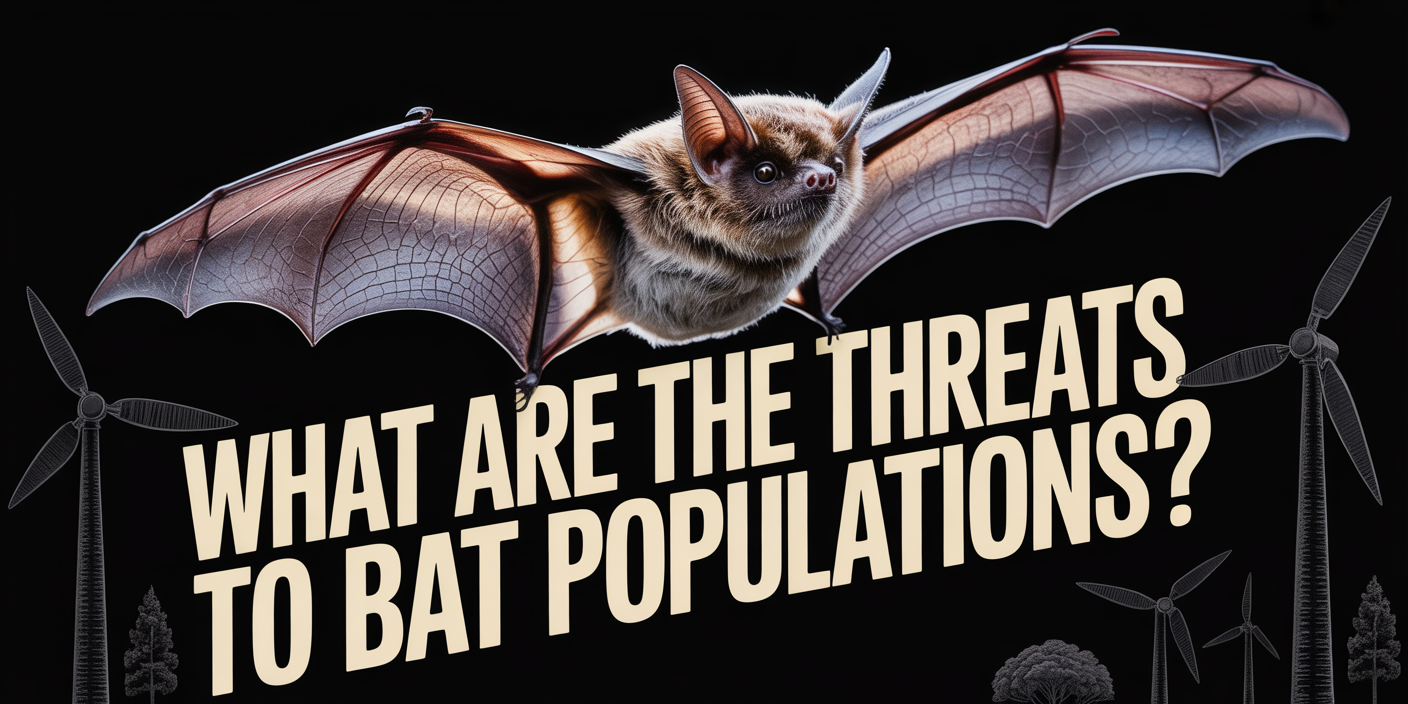Bat populations face numerous threats, including habitat loss, disease, and climate change. These challenges, along with human activities such as pesticide use and disturbances to roosting sites, contribute to the decline of bat numbers globally.
Bats play a vital role in ecosystems, from controlling insect populations to pollinating plants. However, these fascinating creatures are facing a number of threats that endanger their populations worldwide. Understanding these risks is essential for developing effective conservation strategies to protect bats and ensure their continued contribution to the environment.
What are the major threats to bat populations?
Bat populations are facing a variety of threats that have led to significant declines in recent years. One of the most pressing issues is habitat loss, which affects bats’ roosting sites and feeding areas. As urban development expands and forests are cleared for agriculture, bats lose the natural environments they rely on for shelter and food. The destruction of caves, hollow trees, and other roosting sites forces bats to seek new, often less suitable, locations, which can lead to stress and population declines. Additionally, the fragmentation of habitats limits the ability of bat colonies to find adequate resources and maintain healthy populations.
Another major threat to bat populations is the spread of diseases, particularly white-nose syndrome, a fungal infection that affects bats during hibernation. This disease has decimated bat colonies in North America, causing large-scale die-offs and severely impacting species like the Little Brown Bat. The fungus grows on bats’ skin, disrupting their hibernation and depleting their energy reserves, which can lead to starvation. While disease is a significant factor in the decline of bat populations, it is often exacerbated by environmental stressors, such as habitat loss and climate change, creating a complex web of threats to these essential creatures.
How does habitat loss affect bat populations?
Habitat loss is one of the most significant threats to bat populations, as bats rely heavily on specific environments for roosting, feeding, and breeding. Deforestation, urbanization, and agricultural expansion have led to the destruction and fragmentation of natural habitats, reducing the availability of safe spaces for bats to live. Roosting sites, such as caves, hollow trees, and man-made structures, are crucial for bats to rest, raise their young, and seek refuge from predators. When these habitats are lost, bats are forced to adapt to new, often unsuitable, areas, which can increase their vulnerability to disease, predation, and starvation.
Furthermore, the loss of feeding habitats, such as wetlands, forests, and grasslands, impacts bats’ access to insects, their primary food source. As agricultural practices and urban sprawl encroach on these areas, bats face a reduction in the availability of insects, which can lead to malnutrition and lower reproductive success. The fragmentation of habitats also makes it difficult for bats to travel between roosting and feeding areas, increasing the energy costs of their daily activities. Protecting and restoring bat habitats is essential for ensuring the survival of these important species and maintaining healthy ecosystems.
What is white-nose syndrome and how does it threaten bats?
White-nose syndrome (WNS) is a fungal disease that has caused widespread declines in bat populations across North America. The disease is named for the white fungus, Pseudogymnoascus destructans, that grows on the noses and wings of hibernating bats. WNS disrupts the bats’ hibernation by causing irritation, leading them to wake up more frequently and deplete their energy reserves faster than they can replenish them. This premature awakening results in starvation, dehydration, and ultimately death, as the bats are unable to find food during their winter dormancy.
White-nose syndrome has had a devastating impact on bat populations, especially among species like the Little Brown Bat, which has seen catastrophic declines. The disease spreads quickly in bat colonies, often wiping out entire populations in a single winter. WNS has been responsible for the deaths of millions of bats, making it one of the most significant threats to bat conservation. Although research is ongoing to find effective treatments and ways to manage the spread of the disease, it remains a major obstacle to bat population recovery and survival.
How does climate change threaten bat populations?
Climate change poses a significant threat to bat populations by altering the environments in which they live and the ecosystems they rely on. Rising temperatures can affect bats’ hibernation patterns, as they rely on stable, cool environments to enter a deep hibernation during the winter months. With warmer winters, bats may wake up prematurely, using up their energy reserves without access to food, leading to starvation and decreased survival rates. Additionally, changes in weather patterns can disrupt migration and breeding seasons, making it harder for bats to find suitable habitats and reproduce successfully.
Furthermore, climate change can also impact the availability of food sources for bats. As temperatures rise, insect populations—which bats rely on for food—may shift in distribution, abundance, and activity cycles. This disruption can result in food shortages, particularly for species that rely on specific insect populations during particular seasons. Extreme weather events such as droughts, floods, and storms can also damage bat habitats, further threatening their survival. As the climate continues to change, bats will face increasing challenges in maintaining their populations and ecological roles.
How do pesticides and chemicals affect bat populations?
Pesticides and chemicals are another significant threat to bat populations, particularly because they affect the insects that bats rely on for food. Many pesticides, especially those used in agriculture, kill insects directly, reducing the available food supply for insectivorous bats. Insects like moths, beetles, and mosquitoes are key sources of nutrition for many bat species, and the decline in insect populations due to pesticide use leaves bats with less food, which can lead to malnutrition and decreased reproductive success. The widespread use of pesticides in farming areas also harms the delicate balance of local ecosystems, reducing biodiversity and further threatening bat survival.
In addition to affecting food availability, chemicals can also have a direct toxic impact on bats. When bats consume contaminated insects, they inadvertently ingest harmful chemicals that can weaken their immune systems, impair their reproduction, and shorten their lifespan. Some pesticides are known to be particularly toxic to bats, leading to neurological damage and reduced ability to navigate and hunt. The accumulation of toxic substances in the bats’ bodies over time can also cause long-term health issues. Reducing pesticide use and promoting more sustainable farming practices is essential to protect both bat populations and the wider ecosystems they help maintain.
How do human activities directly harm bat populations?
Human activities have a profound impact on bat populations, with both direct and indirect consequences. One of the most immediate threats is the disturbance of bat roosting sites. Bats often rely on caves, abandoned buildings, and even bridges to roost, but these sites are frequently disturbed by human activity, such as tourism, construction, and vandalism. Disturbing a bat colony during its hibernation period can cause significant stress, leading to premature awakening, which depletes their energy reserves and can result in death. In some cases, bat habitats are destroyed altogether, leaving them with no safe place to roost.
Additionally, bats are at risk from human infrastructure, such as wind turbines, power lines, and vehicles. Collisions with wind turbines have been particularly deadly for many bat species, especially those that migrate or travel long distances. Vehicles, especially those on rural roads, can also pose a risk as bats, particularly during their migrations, are often hit by cars. The increasing urbanization of bat habitats, along with the expansion of transportation networks, creates more hazards for bats, ultimately contributing to the decline of their populations. Efforts to minimize these threats through conservation planning and wildlife protection laws are crucial for bat survival.
What role do predators play in the decline of bat populations?
Predation is a natural threat to bat populations, though its impact is generally less severe than other factors like habitat loss or disease. Bats, especially young ones, are vulnerable to a range of predators, including birds of prey, raccoons, and snakes. Owls, hawks, and falcons are particularly adept at hunting bats, using their keen vision and flight abilities to catch them mid-air. Additionally, larger mammals such as raccoons may raid bat roosting sites, preying on juvenile bats or even adult bats when they are most vulnerable. Predation can lead to significant losses, particularly in young bat colonies, which can ultimately affect the stability of the population.
However, predation is part of a balanced ecosystem, and many bat species have evolved to minimize these risks through behaviors like roosting in inaccessible locations, such as caves or high tree branches. Nonetheless, when bat populations are already stressed by other threats, such as disease or environmental changes, predation can exacerbate the situation. For instance, weakened bats, due to malnutrition or disease, may be easier targets for predators. While predators are a natural part of the ecological cycle, the compounded effects of predation, especially in already declining bat populations, contribute to the overall risk to their survival.
Can bats be protected from these threats?
Yes, bats can be protected from many of the threats they face, but it requires concerted efforts at the individual, community, and governmental levels. One of the most effective ways to protect bats is through habitat conservation and restoration. Preserving and creating safe roosting sites, such as bat houses and protected caves, helps ensure that bats have safe places to sleep, raise their young, and hibernate. Additionally, habitat restoration efforts, such as replanting native vegetation and creating corridors for migration, can help mitigate the effects of habitat fragmentation. By safeguarding the environments bats rely on, we can give them a better chance of survival in the face of growing threats.
Another key strategy is reducing human-induced hazards. This includes regulating pesticide use to protect bat food sources, as well as creating wildlife-friendly infrastructure, such as bat-safe wind turbines and safe passageways for migrating bats. Public education and awareness campaigns are also crucial in encouraging communities to respect bat habitats and discourage harmful activities. Legal protections, such as bat conservation laws and regulations for safe roosting sites, can further support bat populations. With these combined efforts, we can help bats overcome many of the challenges they face and contribute to their long-term survival.
Protect Your Home from Bat Intrusions
If bats have become a problem in your home or attic, AAAC Wildlife Removal is here to help! Our experienced team specializes in humane bat removal, ensuring your home remains safe and bat-free. We offer thorough inspections, safe exclusion methods, and long-term solutions to prevent bats from returning.
Contact us today to schedule a consultation and protect your home from unwanted bat intrusions. Let us help you create a bat-free environment with professional, reliable services you can trust.
Conclusion
Bat populations are facing numerous threats, from habitat loss and climate change to disease and human activities. These challenges have put many bat species at risk, causing significant declines in their numbers and threatening their vital role in ecosystems. Bats are crucial for controlling insect populations, pollinating plants, and dispersing seeds, making their protection essential not only for their survival but for the overall health of our environment. If these threats are left unchecked, we risk losing these remarkable creatures and the benefits they provide to nature.
The urgency of bat conservation cannot be overstated. By addressing the key threats and implementing protective measures, we can help ensure the survival of bats for future generations. From habitat restoration and pesticide regulation to legal protections and public education, every action counts in safeguarding bat populations. It is our responsibility to protect these incredible creatures, not only because of the ecosystem services they provide but also as a part of the biodiversity we must strive to preserve. With ongoing conservation efforts, we can support bat populations and maintain the balance of the ecosystems they help sustain.




